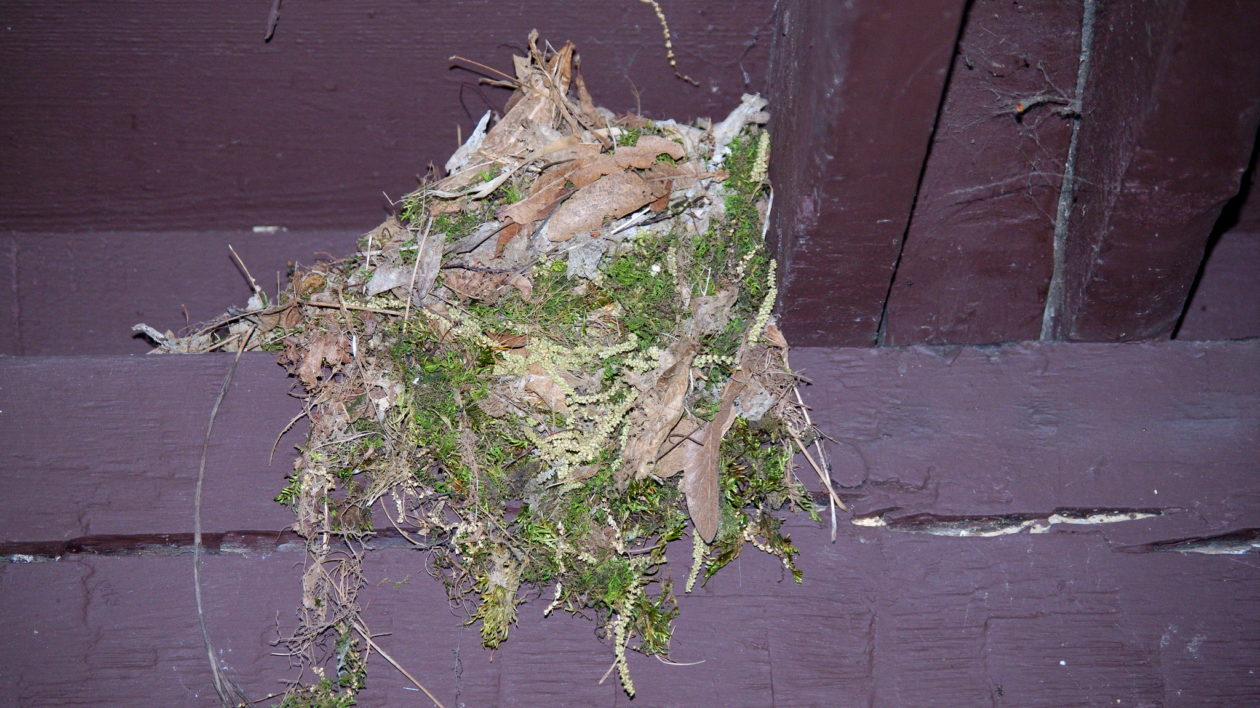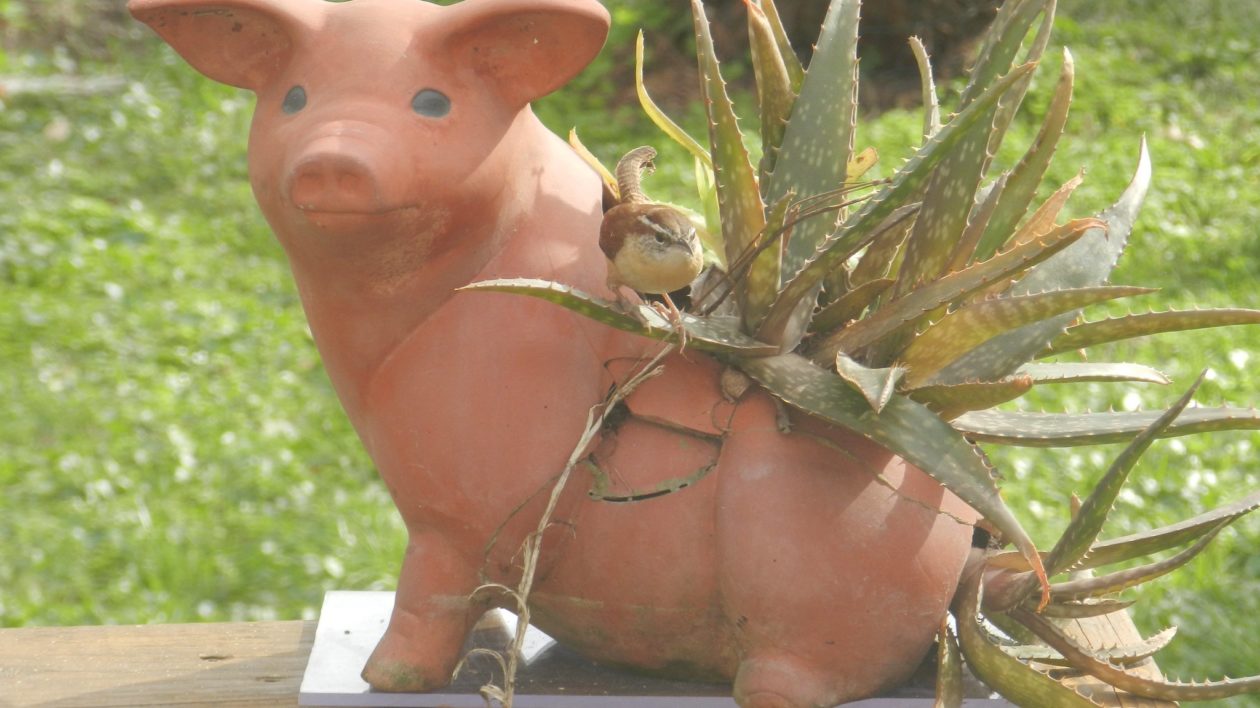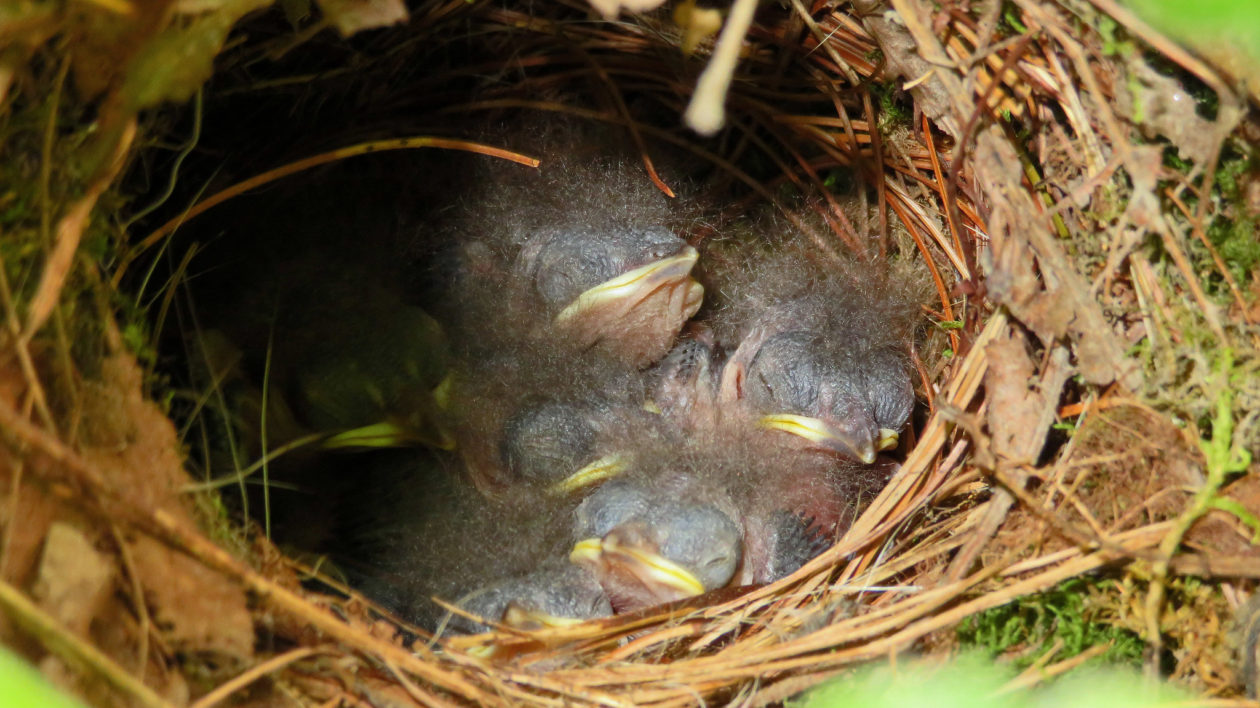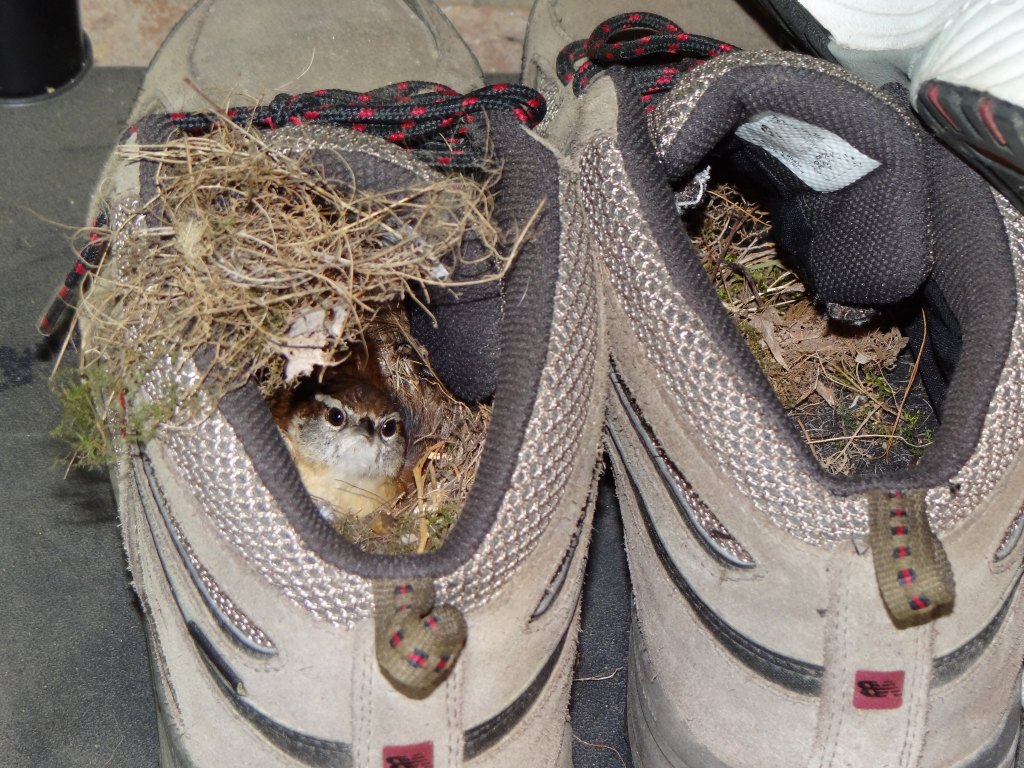You probably wouldn’t be surprised to find a bird nesting in a huge pile of sticks and brush.
To find a nest, or two, in your garage, your grill, or even in the spare tire of your jeep? Now that’s another story. The culprit? It’s most likely the doing of a Carolina wren.
This cavity-nesting, insect-eating, chestnut and cinnamon-colored bird weighing less than a soup spoon seems to know no boundaries when it comes to choosing a home. Sometimes, we might even wonder if our efforts to provide nest boxes and brush piles somehow fail to meet the Carolina wren’s creative standards.
Sometimes it’s as if they ignore the tidy nest and pick propane hoods and the insides of muddy boots instead.
As I wrote in a previous blog, the Carolina wren has adapted quite well to cities and suburbs. And one of the reasons is its willingness to nest in, well, just about anything.
But why do the wrens seek human objects for nesting?

Of Nest Boxes and Brush Piles
Let’s start with nest boxes and brush piles.
During the breeding season, a breeding pair may seek out a nest box, a human-made enclosure frequently utilized for birds to build their nest. Putting up a nest box before the breeding season is vital; this way, the pair will be familiar with its location and know that it is available for their use.
Along with nest boxes, wrens seem to favor what brush piles have to offer. Brush piles give them a quick place to flee from predators. They also provide a potential nesting spot as well as a source for bugs and other critters that Carolina wrens may eat.
Brush piles and nest boxes offer wrens a more convenient (at least for us humans) place to build their nests, though it seems that even with our efforts, wrens may still prefer our mailbox over a nest box. Though classified as cavity-nesters, it seems that Carolina wrens usually forsake tree cavities and nest boxes in favor of more unusual nest sites. In fact, it is leaving some avid birdwatchers, like Amber Silfies, quite confused, yet intrigued.
“We are unsure of why the change; there has been no change in landscaping other than some maturity in shrubs,” she says. “Also in spite of provided nesting boxes, this behavior continues.”

The Nest in the Mailbox
The nest of a Carolina wren is relatively bulky and can be made of various debris such as leaves, hay/grass, twigs, moss, and even strips of bark. They are very versatile nesters and have gotten creative when it comes to their nesting locations. One recent study noted some to build their nests in garden pots. They have also been known to nest in other peculiar places such as mailboxes and even shoes left outside for long periods of time!
It even seems that when the garage door gets left open for long amounts of time, wrens will be busy at work.
“We’ve lived in our home in suburban Atlanta for14 years and we have spent every spring and summer chasing Carolina Wrens from our attached garage” says Silfies. “If the garage door gets left open for more than a couple of hours they particularly like starting nests in our reusable shopping bags hanging from a rack or finding nooks and crannies in shelf storage areas.”

Spares tires also seem to be a favorite of wrens.
Dr. Jeremy Hyman, biology professor at Western Carolina University, recalls when one happily chose his spare tire as its nesting spot.
“I live in a very rural, highly forested neighborhood, and the last 2 years in a row, Carolina wrens have nested successfully in the spare tire on the back of my car. Luckily, I didn’t have to drive much this summer.”
Indeed it seems that Carolina wrens are a very curious species, being able to get almost close to humans by exploring and utilizing our objects is fascinating.
“Perhaps Carolina wrens’ habit of exploring human objects and structures for food predisposes them to be unafraid of unfamiliar objects,” says Hyman, who also completed his PhD work studying Carolina wrens.
So why exactly do wrens do this? Well, there is no clear answer, but there are speculations. They may feel safer being close to humans and certain objects may help them to stay hidden from predators. Or these unusual objects may be convenient for a wren. From the wren’s perspective, there really seems to be no difference in occupying other objects aside from nest boxes and brush piles.
So the next time you go to move your flower pots or put your feet in shoes that have been left outside, check inside first; there may be a wren renting.




I moved into a rental home in upstate this past year. To accommodate my dogs and to allow them to fully utilize the enclosed backyard, I started leaving my backdoor slightly open. Well you guessed it, I now have a CW nesting in the top shelf in my kitchen’s built in hutch. So far we have a decent cohabitating relationship. Hopefully it stays that way.
We had to take our Christmas wreath off the front door early this past December, because birds kept trying to build nests in it. Every time we went in or out of the front door, a bird would fly out of that wreath and startle us! It hit me in the chest a couple of times, when I was opening the door to go inside the house. I had enough and finally took the wreath off the door and placed it back on its hook in the garage until next Christmas. Well. That was six months ago. Two weeks ago (middle of June, 2022), I was repotting some plants and working in the garage. I noticed a small bird fluttering around, so I opened the garage door and out he went. I closed the door after him, and a few minutes later I heard some noise and I look toward the sound. There he was again, fluttering about, so again I opened the garage door. He wouldn’t leave. He just stood posted at the end of a clothing rack. I noticed he had a bug in his beak, so I figured he wanted to enjoy it in peace. I left the garage door open, went inside the house and did some laundry. When I went back out to garage, he was gone. I closed the garage door, and went back to work repotting the plants. A little while later, I heard a noise again. I looked toward it, and saw that bird squeezing through a gap at the top of the garage door, coming inside! I just watched; a little annoyed, but more curious. He had another bug in his beak. I grabbed my phone and started video-recording. He hopped on various things and fluttered across the garage, then jumped up and disappeared into that Christmas wreath hanging on the wall. I kept recording, and zoomed in. I saw the top half of a domed nest, right in the center-bottom of the wreath opening. Right next to the big red bow, lol. I heard the babies crying and wanting more food. Then out he came, taking the same hopping and fluttering path that brought him there. He stopped and perched at the top of the garage door before he scooted out, and started yelling at me. Looking right at me, screaming at the top of his lungs. He was so noisy and loud. And so rude… in MY garage, lol! I went back inside, so the neighbors wouldn’t think I was torturing some poor critter. I googled and searched, and figured out that he was a Carolina Wren. Learned all about these curiously bold birds. So interesting. Little birds with big personalities! I think it’s precious that the male and female bond and mate for life. That was five days ago. Since then, I have heard the pair singing so pretty through the garage wall, while in my living room. We have learned to tolerate each other and coexist in the garage. He still gets a little antsy when I’m out there, but I believe he knows I’m not going to hurt him, or her, or the babies. So he goes about his bug-delivering business. Actually, he knows I’m ok. I’ve been offering him live mealworms several times a day, from my daughter’s supply that she has for her leopard gecko. Mr. Wren was hesitant at first, but now gladly accepts the free mealworms. Less work he has to do. I can’t wait to see the babies. The wreath is too high and the babies must still be so small, way down in the bottom of the nest. I cannot get a good view. I’m sure they’ll start peeking out the entrance hole soon. Then all we’ll see are big open mouths, crying for food, lol. They only spend about two weeks or so in the nest after hatching, so it’ll soon enough, and they’ll be jumping and fluttering and fledging around in my garage. Hoping they don’t make too much of a mess. But oh well. Nature is truly amazing. I love that my kids and I get to witness it up close. 🙂
While experiencing some Wren nest building today I noticed 4 to 5 wrens all joining in the process.
Is this a common observance and do you know the reasoning behind this?
We got 4 eggs I think the mom will lay more eggs how we do we know
A pair of wrens have built a nest in my flower pot next to my back door. The pot is attached to the wall and has a fern growing in it. They work on the nest every morning for a couple of hours then disappear until the next morning. They’ve been hard at work for several days. We use our back door often to let our chihuahua out or to use our grill. Is this going to disturb the wren when it comes to nesting and the incubation period? They’ve worked so hard and I don’t want to disturb them once the eggs are laid and they begin they’re little bird family.
What do I do?
A couple of years ago, I woke up to hear something banging around the mailbox. When I went to put out the mail, I found the mailbox full of nesting material. The wrens managed to work their way under the mailbox cover. I dumped the material out, only to have the same thing happen the next day. And every day after, until I started covering the mailbox each evening with a plastic bag. I left a note for our mail carrier, and he would lift the bag to leave our mail in the box. Sadly, the wrens never used the box I put out for them. However. . . Today as I was preparing to cover the outdoor faucet, I saw a nest with 2 eggs in the styrofoam faucet cover. Being the first of January, I doubt the eggs are viable, but I carefully transferred the nest to an empty flower pot and put it back on the shelf. We’ve had warmer than usual weather, so I wonder if the eggs could have been laid as late as December.
Why do they stuff the entrance when they leave? Two years in a row.
I’ve got a pair who made a nest at the top of a grain bag I collected horse manure in and left in my barn… of all the places! I would typically take the bag to my burn pit, but of course I’ll now be waiting for this little family to leave. It’s been so much fun watching the eggs hatch and seeing the babies grow. I just worry that “The Sheriff,” a huge corn snake who has freely inhabited my barn in exchange for his rat catching services for about 8 years now, doesn’t find them!
Once the babies have left the nest, should I leave the nest or clean it out? Our 4 babies were born in a hanging planter on my front porch. I don’t know if they will reuse that nest or if I should remove the nest from my planter.
Have some Wren babies in my potted pineapple sage plant. Mom goes back and forth between my big tree on the front yard to the nest in my plant on my front porch. I don’t mind her little family hanging out ☺️
Can I move nest?
A nest in my orchid tray. No eggs. In four weeks take tray with me on vacation.
We have them nest every year in different areas around our home. They seem to prefer anything besides the nest box we hung up. The nests have been in flower pots, in a empty fish tank and once in a bicycle helmet. Twice they made nests in the canvas awning next to our back door and the mommy wren flew into our house (on accident) when it was spooked by my husband going out the door.
Years ago, my father and I grew plants and trees in a greenhouse on our property. One day during the start of winter, my dad walked into the greenhouse to find a dusting of ash on many of the plants. Turns out, following some deductive reasoning, a male Wren had chosen the radiator-style heater to try to impress his female counterpart with his latest nesting site. We never noticed any fledglings trying to find their way out of the greenhouse, and I am sure that the female understood this dilemma and therefore marked this site off of the list, while exclaiming to the male, “You’re an idiot!”
The incredible part of the story is the curious tenacity of the male, who would have had to time his entry and exit of the greenhouse through the automated, thermostat-controlled 2′ x 2′ louver-style ventillation system window and fan that would kick on; opening and closing frequently during warm/hot spells of spring/summer. The mystery of the ash had been solved. The nest, which had been abandoned for sometime , caught fire during the first (cold-spell) firing up of the propane-generated heater. As the heater reached its optimal temperate, the nest material was incinerated. The fan then turned on at the back of the radiator distributing heat and ash onto the plants. Luckily, there was no harm to the birds, plants, or greenhouse.
I had a CW nest in the cover on top of my propane tank. I found the nest with eggs in late Aug and they fledged the 2nd week of Sept in Maine! All I could think was that they would have fried in the sun if they nested there in July.